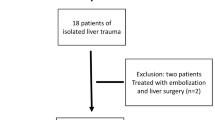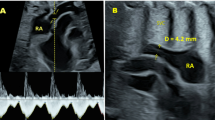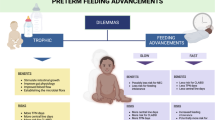Abstract
Recent data suggest that umbilical venous perfusion of the fetal liver has an important influence on fetal growth and postnatal liver function, and that maternal factors in late pregnancy modify this circulation. In a longitudinal study of 160 low-risk pregnancies, we determined how umbilical and portal venous blood flows to the fetal liver changed during gestation, and examined the hypothesis that maternal body mass index and pregnancy weight gain influenced fetal liver blood flows. We measured blood flows in the umbilical and portal veins, left portal branch, and ductus venosus using ultrasound. Normalizing for estimated fetal weight, fetal liver total venous blood flow fell from 84 to 57 mL · min−1 · kg−1 during 21–39 wk of gestation; toward term the portal contribution increased (from 14 to 20%) and the umbilical contribution fell, whereas distribution between the left and right liver lobes was stable, 60%/40%. Greater flow of nutrient-rich umbilical venous blood to the liver was associated with higher birth weight and neonatal ponderal index. Maternal body mass index was not related to fetal liver blood flows, but low pregnancy weight gain strongly influenced flow distribution between the right and left liver lobes, sparing the left lobe and increasing the difference between lobes by 16%.
Similar content being viewed by others
Log in or create a free account to read this content
Gain free access to this article, as well as selected content from this journal and more on nature.com
or
Abbreviations
- BW:
-
birth weight
- DV:
-
ductus venosus
- LPV:
-
left portal vein
- PV:
-
portal vein (main stem)
- UV:
-
umbilical vein
References
Barker DJ, Osmond C 1986 Infant mortality, childhood nutrition, and ischaemic heart disease in England and Wales. Lancet 1: 1077–1081
Godfrey KM, Barker DJ 2001 Fetal programming and adult health. Public Health Nutr 4: 611–624
McMillen IC, Robinson JS 2005 Developmental origins of the metabolic syndrome: prediction, plasticity, and programming. Physiol Rev 85: 571–633
Tchirikov M, Kertschanska S, Sturenberg HJ, Schroder HJ 2002 Liver blood perfusion as a possible instrument for fetal growth regulation. Placenta 23: S153–S158
Tchirikov M, Kertschanska S, Schroder HJ 2001 Obstruction of ductus venosus stimulates cell proliferation in organs of fetal sheep. Placenta 22: 24–31
Haugen G, Hanson M, Kiserud T, Crozier S, Inskip H, Godfrey KM 2005 Fetal liver-sparing cardiovascular adaptations linked to mother's slimness and diet. Circ Res 96: 12–14
Edelstone DI, Rudolph AM, Heymann MA 1978 Liver and ductus venosus blood flows in fetal lambs in utero. Circ Res 42: 426–433
Emery JL 1963 Functional asymmetry of the liver. Ann NY Acad Sci 111: 37–44
Emery JL 1956 The distribution of haemopoietic foci in the infantile human liver. J Anat 90: 293–297
Ring JA, Ghabrial H, Ching MS, Shulkes A, Smallwood RA, Morgan DJ 1998 Propranolol elimination by right and left fetal liver: studies in the intact isolated perfused fetal sheep liver. J Pharmacol Exp Ther 284: 535–541
Cox LA, Schlabritz-Loutsevitch N, Hubbard GB, Nijland MJ, McDonald TJ, Nathanielsz PW 2006 Gene expression profile differences in left and right liver lobes from mid-gestation fetal baboons: a cautionary tale. J Physiol 572: 59–66
Gill RW, Kossoff G, Warren PS, Garrett WJ 1984 Umbilical venous flow in normal and complicated pregnancy. Ultrasound Med Biol 10: 349–363
Barbera A, Galan HL, Ferrazzi E, Rigano S, Jozwik M, Battaglia FC, Pardi G 1999 Relationship of umbilical vein blood flow to growth parameters in the human fetus. Am J Obstet Gynecol 181: 174–179
Acharya G, Wilsgaard T, Rosvold Berntsen GK, Maltau JM, Kiserud T 2005 Reference ranges for umbilical vein blood flow in the second half of pregnancy based on longitudinal data. Prenat Diagn 25: 99–111
Kiserud T, Rasmussen S, Skulstad S 2000 Blood flow and the degree of shunting through the ductus venosus in the human fetus. Am J Obstet Gynecol 182: 147–153
Bellotti M, Pennati G, De Gasperi C, Battaglia FC, Ferrazzi E 2000 Role of ductus venosus in distribution of umbilical blood flow in human fetuses during second half of pregnancy. Am J Physiol Heart Circ Physiol 279: H1256–H1263
Kessler J, Rasmussen S, Hanson M, Kiserud T 2006 Longitudinal reference ranges for ductus venosus flow velocities and waveform indices. Ultrasound Obstet Gynecol 28: 890–898
Kessler J, Rasmussen S, Kiserud T 2007 The fetal portal vein: normal blood flow development during the second half of human pregnancy. Ultrasound Obstet Gynecol 30: 52–60
Kessler J, Rasmussen S, Kiserud T 2007 The left portal vein as an indicator of watershed in the fetal circulation: development during the second half of pregnancy and a suggested method of evaluation. Ultrasound Obstet Gynecol 30: 757–764
Johnsen SL, Rasmussen S, Sollien R, Kiserud T 2004 Fetal age assessment based on ultrasound head biometry and the effect of maternal and fetal factors. Acta Obstet Gynecol Scand 83: 716–723
Kiserud T, Rasmussen S 1998 How repeat measurements affect the mean diameter of the umbilical vein and the ductus venosus. Ultrasound Obstet Gynecol 11: 419–425
Haugen G, Kiserud T, Godfrey K, Crozier S, Hanson M 2004 Portal and umbilical venous blood supply to the liver in the human fetus near term. Ultrasound Obstet Gynecol 24: 599–605
Kiserud T, Eik-Nes SH, Blaas HG, Hellevik LR, Simensen B 1994 Ductus venosus blood velocity and the umbilical circulation in the seriously growth-retarded fetus. Ultrasound Obstet Gynecol 4: 109–114
Kiserud T 2005 Venous hemodynamics. In: Maulik D (ed) Doppler Ultrasound in Obstetrics and Gynecology. Springer-Verlag, Berlin, Heidelberg, New York, pp 57–67
Pennati G, Bellotti M, Ferrazzi E, Bozzo M, Pardi G, Fumero R 1998 Blood flow through the ductus venosus in human fetus: calculation using Doppler velocimetry and computational findings. Ultrasound Med Biol 24: 477–487
Kiserud T, Hellevik LR, Hanson MA 1998 Blood velocity profile in the ductus venosus inlet expressed by the mean/maximum velocity ratio. Ultrasound Med Biol 24: 1301–1306
Skjaerven R, Gjessing HK, Bakketeig LS 2000 Birthweight by gestational age in Norway. Acta Obstet Gynecol Scand 79: 440–449
Johnsen SL, Rasmussen S, Wilsgaard T, Sollien R, Kiserud T 2006 Longitudinal reference ranges for estimated fetal weight. Acta Obstet Gynecol Scand 85: 286–297
Rohrer F 1908 [A new formula for the determination of the body abundance]. Ges Anthropol 39: 5–8
Gill RW, Trudinger BJ, Garrett WJ, Kossoff G, Warren PS 1981 Fetal umbilical venous flow measured in utero by pulsed Doppler and B-mode ultrasound. I. Normal pregnancies. Am J Obstet Gynecol 139: 720–725
Boito S, Struijk PC, Ursem NT, Stijnen T, Wladimiroff JW 2002 Umbilical venous volume flow in the normally developing and growth-restricted human fetus. Ultrasound Obstet Gynecol 19: 344–349
Kiserud T, Kilavuz O, Hellevik LR 2003 Venous pulsation in the fetal left portal branch: the effect of pulse and flow direction. Ultrasound Obstet Gynecol 21: 359–364
Sutton MG, Plappert T, Doubilet P 1991 Relationship between placental blood flow and combined ventricular output with gestational age in normal human fetus. Cardiovasc Res 25: 603–608
Kiserud T, Ebbing C, Kessler J, Rasmussen S 2006 Fetal cardiac output, distribution to the placenta and impact of placental compromise. Ultrasound Obstet Gynecol 28: 126–136
Nicolaides KH, Soothill PW, Clewell WH, Rodeck CH, Mibashan RS, Campbell S 1988 Fetal haemoglobin measurement in the assessment of red cell isoimmunisation. Lancet 1: 1073–1075
Doughty I, Sibley C 1995 Placental transfer. In: Spencer J, Rodeck C (eds) Fetus and Neonate Physiology and Clinical application. Vol 3: Growth. Cambridge University Press, Cambridge, New York, Melbourne, pp 3–29
Jacobsson H, Jonas E, Hellstrom PM, Larsson SA 2005 Different concentrations of various radiopharmaceuticals in the two main liver lobes: a preliminary study in clinical patients. J Gastroenterol 40: 733–738
Pennati G, Bellotti M, De Gasperi C, Rognoni G 2004 Spatial velocity profile changes along the cord in normal human fetuses: can these affect Doppler measurements of venous umbilical blood flow?. Ultrasound Obstet Gynecol 23: 131–137
Author information
Authors and Affiliations
Corresponding author
Additional information
This study received financial support from the National Health Council, Norway and Haukeland University Hospital, Bergen.
Rights and permissions
About this article
Cite this article
Kessler, J., Rasmussen, S., Godfrey, K. et al. Longitudinal Study of Umbilical and Portal Venous Blood flow to the Fetal Liver: Low Pregnancy Weight Gain is Associated With Preferential Supply to the Fetal Left Liver Lobe. Pediatr Res 63, 315–320 (2008). https://doi.org/10.1203/PDR.0b013e318163a1de
Received:
Accepted:
Issue date:
DOI: https://doi.org/10.1203/PDR.0b013e318163a1de
This article is cited by
-
Fetal Physiologically Based Pharmacokinetic Models: Systems Information on Fetal Cardiac Output and Its Distribution to Different Organs during Development
Clinical Pharmacokinetics (2021)
-
Human supraphysiological gestational weight gain and fetoplacental vascular dysfunction
International Journal of Obesity (2015)
-
Velocity profiles in the human ductus venosus: a numerical fluid structure interaction study
Biomechanics and Modeling in Mechanobiology (2013)
-
Human Ductus Venosus Velocity Profiles in the First Trimester
Cardiovascular Engineering and Technology (2013)



